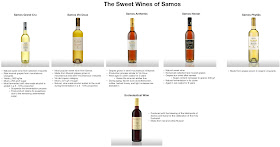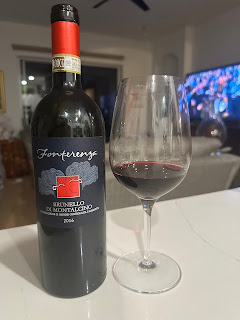The Muscat grape is one of the oldest and most widespread grape families in the world, splitting, as it did, from the main branch of vitis vinifera some 10,500 years ago. The, predominantly, white wine has a pronounced aromatic quality due to the higher-than-average presence of aroma compounds in the berry. The most planted of the over 200 cultivars in the family are Muscat Blanc á Petits Grains and Muscat of Alexandria and my survey of these cultivars began with a review of the former as implemented in the wines of Asti DOCG. In this post I continue the survey with a review of the Muscat wines of Samos, Greece.
Lying just 1 mile off the western coast of Turkey, the Greek North Aegean island of Samos shows occupation layers back to Neolithic times, has been ruled by every historical Western Asia great power, and is, today, one of the world renowned producers of wines from the Muscat grape.
Samos is the birthplace of notables such as Pythagoras (Greek philosopher and mathematician) Melissus of Samos (philosopher), Epicurus (philosopher), and Aristarchus of Samos (astronomer) and is the location of historically significant sites such as the Pythagorian and the Heraion of Samos.
While the wines of Samos have been praised by Hippocrates and Theophiastos, it is unlikely that the mentioned wines were from the Muscat variety. The island was repopulated with peoples from all across Greece in the latter half of the 16th century and, according to samosin.gr (Viniculture at Samos), it is most likely that the Muscat grape was first brought to the island from Asia Minor around this time. According to the same source, the Muscat wine of Samos was first mentioned in the poem of Kaisarios Daponte (1714 - 1784) a priest and scholar from Skopelos.
History
In the early 18th century, Samos Muscat was traded to nearby Chios, Rhodes, Smyrna, and Constantinople. By mid-century it had reached the Russian market in Odessa and Taganrog. There is mention of a 3000-barrel Muscat wine production on the island in 1787 by a German named Friesman.
There was a decrease in production during the 1821 War of Independence but, overall, there were improvements in wine production and consumption during the 19th century. The French winemaker Faye was called to the island by the Government to teach advanced grapegrowing and winemaking techniques to Samian farmers. Shortly after, a young Samian was sent to France to learn winemaking techniques which he was expected to share with fellow winemakers upon his return.
During this period trade links expanded into the Ottoman Empire, Egypt, Italy, Netherlands, and France and foreign companies settled on the island to be close to the grape sources.
There were significant vineyard losses during the latter half of the 19th century:
- Blight during the 1850s was ameliorated by the use of sulfur
- Phylloxera struck in 1892 and destroyed most of the vineyards, leading to a switch to tobacco
- Vineyards were restored with the introduction of American rootstocks.
The foreign companies that were established on the island had pricing power over the many small growers so formation of some type of Coop had been under consideration since 1865. However, such a Coop was not founded until 1934. The now named United Winemaking Agricultural Cooperative of Samos (UWC Samos) has 2000+ growers as members. UWC Samos receives the grapes, produces the wine, and trades almost the entire production.
Physical Environment
Samos is 45 km (30 miles) from east to west, with several distinct mountain formations running across it. The mountains are separated by plains and valleys, the former of which is populated by olive groves and citrus trees. Bushes, pine forests, plane trees, cypresses, and chestnuts round out the large-scale flora on the island.
The soils are gravel, schistolistic, well-drained and moderately fertile. No irrigation is allowed.
There are over 1400 ha of vineyards distributed across the island, with most found on the north side between Karlovasi and the city of Samos, especially on the northern slopes of the centrally located Mount Ampelos where:
- Vines are protected from warm southerly winds
- Altitudes of up to 900 m temper the warm Mediterranean climate
- High diurnal temperature is the norm
- Slows ripening
- Aids development of aroma and character
- Allows acidity retention.
Ninety-eight percent of the vines are Muscat. Vineyards are mountainous and semi-mountainous with the best wines coming from sites located at altitudes between 500 and 600 m. The cup-shaped vines are grown on dry stone terraces which are designed to hold and drain soils. The traditional vineyard architecture is illustrated in the pictures below.
 |
| Terraced Samos vineyard (Source: samoswine.gr) |
 |
| Close-up of Samos stone terraces (Source: samoswine.gr) |
 |
| Training of Samos Muscat vines (Source: samoswine.gr) |
Samos Wines
The sweet rich wines from Muscat Blanc á Petits Grains are among Greece's most famous, exported as they are around the world. These wines are produced centrally in the two UWC Samos wineries located in Malagari and Karlovasi, respectively. Karlovasi produces wine from grapes grown in the northern part of the island while the Malagari winery services the grapes grown elsewhere. The Malagari site also serves as the home of the Samos Wine Museum.
UWC of Samos produces around 5 million liters of wine annually with 70% of the production exported to 25 countries. Ninety-eight percent of the wine produced is white with the remainder reds from varieties including Ritino, Fakiano, and Avgoustiatis. The sweet wines produced by the Coop are illustrated in the chart below.
The Coop does produce some dry wines (e.g., Samaina, a dry Rosé from two rare reds, and a Retsina) but they are less prominent.
Trends
Writing on Giannis Karakasis MW's Greek Wine Explained (10/28/20), Evangelie Kostaki noted a few key trends as regards Samos wine:
- Between 2012 and 2020, a number of new wineries had "popped up" and the newer ones were run by "young people"
- Creation of new wine styles
- Single-vineyard wines versus cross-island wines
- Muscat Nature Selection
- Dry wines
- Samos embracing the potential of producing quality dry wines from Muscat Blanc á Petits Grains
- Vineyard changes
- Uproot vineyards in the plains
- Close to the sea
- Diseases tend to flourish due to high humidity
- Heavy, fertile soil with high water-holding capacity not ideal for highest quality wines
- Plantings sporadically increasing in semi-mountainous areas
- Better aeration
- Large diurnal range
- Sufficient ripening.









